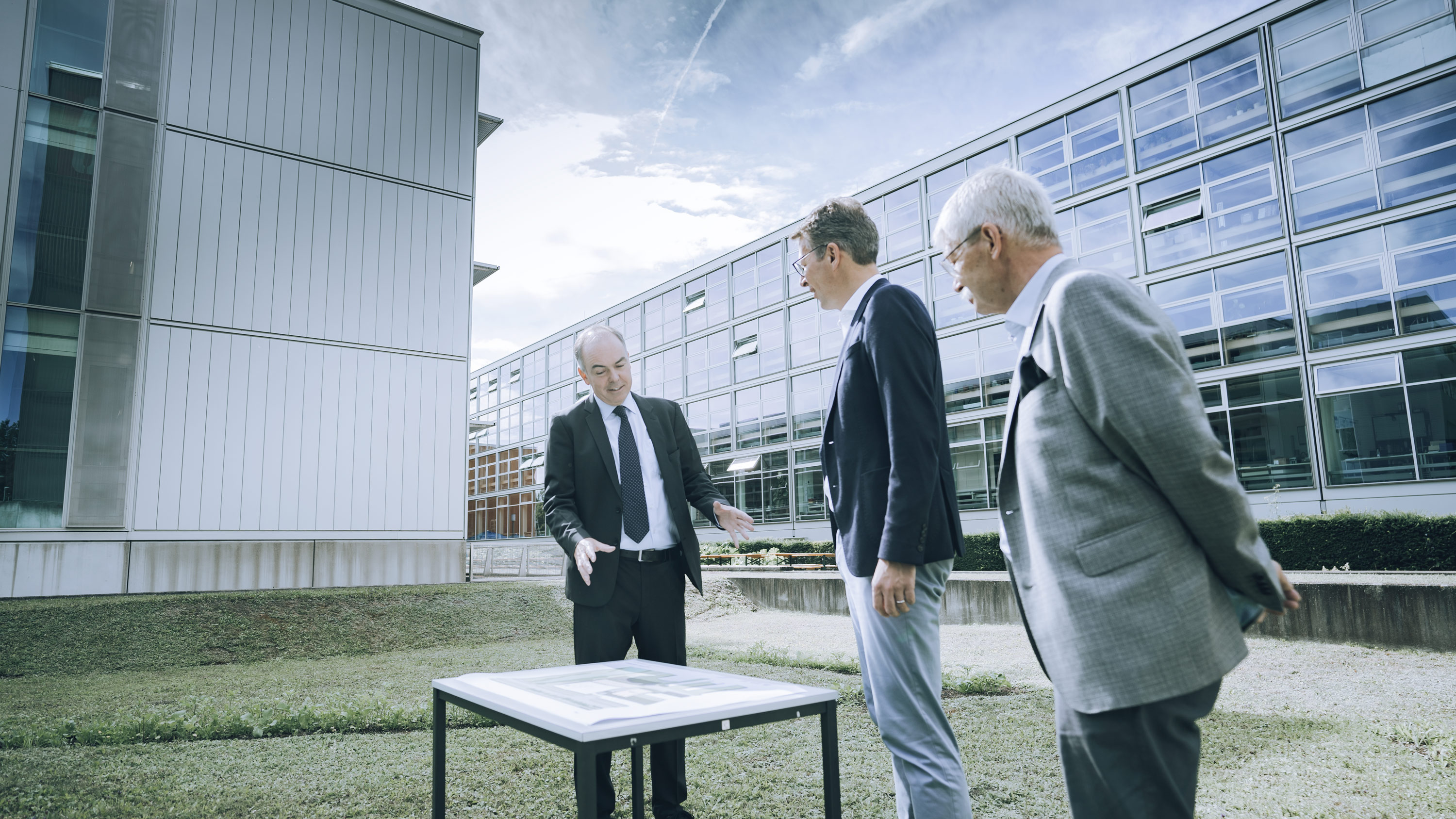The Leibniz Supercomputing Centre is an organization familiar with computer science history— it was one of the first connections to the German Scientific Network (Deutsches Forschungsnetz, DFN) already in the 1980s. It hosted the first hot water-cooled supercomputer on the top 500 list of the world's fastest supercomputers in 2012. The first German quantum demonstrator is in progress in Garching. On top of these milestones, an exascale supercomputer for Bavaria and seated at LRZ was just announced for the years to come. The institute of the Bavarian Academy of Sciences and Humanities (BAdW) has actively shaped German—but also European and global—computer science history over the past 60 years.
Garching/Munich, July 14, 2022 - Happy birthday: The Leibniz Supercomputing Centre (LRZ) turns 60 years old, with its Centre for Virtual Reality and Visualization (V2C) also turning 10. During today’s celebratory event, LRZ leadership, users past and present, and government officials shared fascinating insights into science and research, showcased a retrospective on the development of computer technology, and led discussions on innovations for IT and digitization of universities and colleges. The Bavarian State Minister for Science and the Arts, Markus Blume, BAdW President Thomas O. Höllmann, and guests from science were among those in attendance.
The Future is Now: The Leibniz Supercomputing Centre turns 60

© StMWK / Axel König. LRZ-Leiter Prof. Kranzlmüller, Wissenschaftsminister Blume und Prof. Höllmann, Präsident der BadW tauschen sich über die künftige Erweiterung des LRZ aus.
Innovative technology enables breakthrough research findings
Dieter Kranzlmüller, Director of the LRZ, gave Minister Blume a tour of the computing centre, highlighting the latest computer technology on site:
- For its Quantum Integration Centre (QIC), LRZ recently acquired its first quantum computer and is focused on integrating it into traditional supercomputers.
- The CS-2 system from Cerebras Systems with HPE Superdome Flex, which was specially developed for artificial intelligence (AI) workloads and offers the highest computing power in smart data processing with the world's largest chip.
"The challenges of our time can only be met by analyzing huge amounts of data. The Leibniz Supercomputing Centre plays a pioneering role in this and has become Bavaria's most renowned flagship for Big Data processing within the last 60 years. With the world's largest AI chip and one of the most powerful supercomputers in Europe, we play in the top league worldwide. And we are continuing to invest massively in the expansion of future technologies. Our billion-dollar innovation offensive –the Hightech Agenda Bayern–with which we also support the LRZ, acts like a catalyst for super- and quantum computing."
At the subsequent ceremony with researchers and partners, the LRZ Board of Directors recalled the history of LRZ’s success. In 1962, the LRZ started out as an IT service provider for the two Munich universities, quickly offered its services to institutes and universities beyond the city limits, grew in the 1990s to become a supercomputing center of international standing, and today accompanies universities and non-university research institutes in Bavaria as a reliable partner in digitization. In 2006, the Academy Institute moved to the Garching research campus.
"The extraordinary development of the Leibniz Supercomputing Centre of the Bavarian Academy of Sciences and Humanities is based on a close interaction of a broad spectrum of basic research and application-oriented implementation. In terms of its innovative capacity, LRZ is actually a permanent startup that is always on the cutting edge and proves that creativity and efficiency need not diminish over the course of sixty years, but - quite the opposite - can even increase," says Academy President Thomas O. Höllmann.
Traditionally ahead: A mindset to stay at the LRZ
Since 1962, LRZ has continually relied on and implemented forward-looking technologies. In 1977, for example, it built the first remote access network, which gave rise to the Munich Scientific Network (MWN) and many new research services. With its experience in large-scale computing systems, LRZ was expanded into a high-performance computing center at the end of the 1980s, and then as a federal high-performance computing center from 2000. To make its data storage convenient and accessible from abroad, the LRZ developed clever networking and other practical services in the cloud, as well as tools and technology to increase the energy efficiency of computers, such as hot water cooling and waste heat utilization through adsorption chillers.
In addition, the LRZ provided practical tools for visualizing research results and transferring them to virtual worlds. Today, its employees are increasingly dedicated to future technologies such as AI and quantum computing. "Our mission at the LRZ remains unchanged: We build IT infrastructures for science and research and remain a reliable partner. But what we have achieved today, we should do even better tomorrow true to our motto #ZukunftbleibtProgramm," says Prof. Kranzlmüller.
In the afternoon, the programme continued with presentations on research and the future of the data centre: Scientists highlighted leading science projects, demonstrating how high-performance computing (HPC), virtual reality, or AI methods are boosting science. Young researchers also presented their ideas for the future of IT, computers and data centers. Together with LRZ Director Kranzlmüller and Laura Schulz, Head of Quantum Computing and Technologies at LRZ, international partners and guests discussed how the integration of AI and quantum processors will accelerate supercomputing.
Check out www.lrz60.de for more LRZ success stories (mostly in German). The recordings of the live stream will be made available shortly after the event as well.